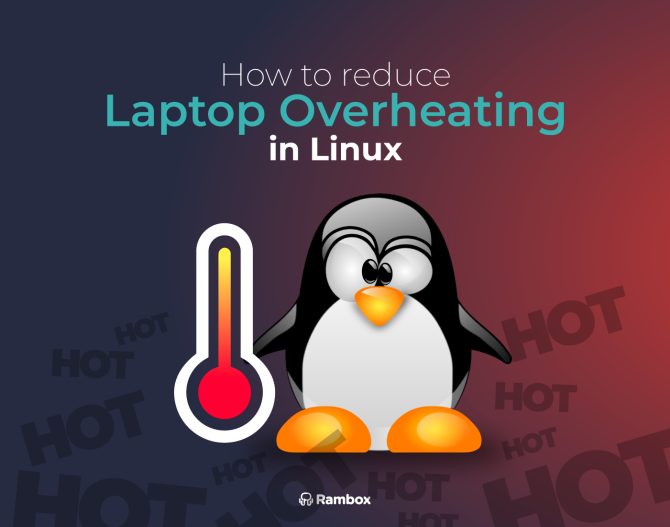Computer overheating is a common and severe problem faced by millions of users worldwide. Typically, this problem occurs in laptops that are used for prolonged periods.
Technological advances have made it possible for devices to become smaller and lighter. Therefore, notebook PCs are nowadays too thin to implement efficient cooling solutions.
You are in luck if you regularly work with a Linux laptop and periodically suffer from overheating on your device. Fortunately, overheating on Linux can be solved with some simple tricks.
This week at Rambox, we give you all the tips and tricks to avoid overheating on Linux PCs.
Contents
Why do computers overheat?
Laptop components are very close together, with hardly any space between them, so there are hardly any ventilation systems and areas through which air can pass.
It is usual for a laptop to heat up to 42-45ºC (107.6-113ºF), so if the device’s temperature exceeds these figures, overheating occurs.
There is a multitude of reasons why a computer may overheat. While the most common cause is an inefficient cooling system, other common causes include the following:
- Blocked ventilation ports due to dust build-up or having an object blocking the hot air outlet.
- Clogged fan.
- Lack of thermal paste on the CPU.
If your device is over three years old, thermal problems will likely reach critical levels, and hardware, software, or a combination of both will need to be implemented.
Tools to optimize Linux thermal performance
You can reduce the temperature of your device by installing some applications on your Linux device. Many applications have different objectives, such as controlling the processing speed or manipulating the fan speed to reduce heat. Depending on your needs, you can install one or more packages.
Rambox
The mere fact of using Rambox already presents benefits in terms of CPU consumption, as the primary goal of the application is to avoid using different desktop applications or opening multiple websites in your browsers, which ultimately increases resource usage on users’ systems causing system overheating.

Rambox concentrates users’ desired applications and websites in the same desktop application, which helps mitigate CPU consumption and overflow.
Rambox comes with an internal App Manager dashboard, which displays real-time metrics for each application and process running within Rambox. Here, users can disable applications or kill processes as well. Open the quick search panel (Alt+Shift+K) and type “app manager” to find it.

Rambox also allows you to instantly disable applications you are not using, which may consume considerable resources in the background. Right-click on the application and select “Enabled” to activate or deactivate the application.

When Rambox detects that some application is consuming a reasonably high amount of CPU, or if the amount of CPU consumption is unusual for a short period, users are automatically notified so they can reload or deactivate the application and prevent it from endangering others or slowing down Rambox in general.

At the same time, Rambox offers an option to automatically hibernate any desired application after a period of idle time, which restricts it from using main memory and pauses its background usage to preserve resources. At this point, users can set several minutes of inactivity, after which the application will be hibernated. Users can also start the desired application that is already hibernated and then “wake it up” when they decide to use it. To configure this option, you only have to right-click on the application, select “Settings,” and add the time you consider appropriate.
TLP
This is one of the best software to help control the temperature of laptops. It is a clean CLI-based application that allows you to save battery power without dealing with complex technical details.
If you have Ubuntu or Debian systems, follow the commands below to install TLP on your system:
- sudo add-apt-repository ppa:linrunner/tlp
- sudo apt-get update
- sudo apt-get install tlp tlp-rdw
If you are using ThinkPads, you will need to add a step:
- sudo apt-get install tp-smapi-dkms acpi-call-dkms
Restart your computer after the installation is complete. Usually, you will start noticing differences after a couple of hours, but don’t worry if you start seeing these changes within a couple of days.
Thermald
This tool monitors and controls the CPU temperature, applying the necessary compensation methods to prevent the temperature from skyrocketing and reducing overheating.
https://manpages.ubuntu.com/manpages/lunar/en/man8/thermald.8.html and can be installed with the following command:
- sudo apt-get install thermald
Rambox, Thermald and TLP do not conflict, so you can install them all on your computer if necessary.
Laptop Mode Tools
Laptop Mode Tools is a power-saving package for Linux systems. It allows different configurations for longer battery life.
Why worry about battery life if you are looking to reduce overheating? Because power saving mode lowers the temperature of computers.
You can use the following WebUpd8 PPA to install Laptop Mode Tools:
- sudo add-apt-repository ppa:webupd8team/unstable
- sudo apt-get update
- sudo apt-get install laptop-mode-tools
You can start the GUI using the following command:
- $ gksu lmt-config-gui
One consideration to keep in mind is that Laptop Mode Tools and TLP do not mix well. Therefore, if you have TLP installed, you will need to uninstall it before proceeding with the Laptop Mode Tools installation.
Monitor the laptop hardware
If you have installed some of the above solutions, be sure to monitor the computer’s temperature to check the effectiveness of their solutions and their benefits.
Linux offers excellent tools that allow users to monitor hardware temperature effectively.
Sensors
The sensors package provides helpful information about the system hardware and comes pre-installed on Ubuntu or Debian-based Linux systems.
The sensors will display the temperature of the processor and each core. A distinction is made between high temperature and critical temperature. Massive overheating may cause the computer to shut down automatically to prevent damage if the processor is at a crucial temperature.
To open the application, use the following command:
- $ sensors
Psensor
Psensor displays CPU, GPU, and HDD temperature, rotation speeds, and heat statistics.
To install Psensor on Ubuntu or Debian, run the following commands:
- sudo apt-get install lm-sensors hddtemp
- sudo sensors-detect
- sudo apt-get install psensor
Remove CPU-intensive applications
If the programs or applications installed on the PC require a lot of CPU power, there will be an increase in the temperature of the device.
Using these applications on older laptops will cause more intense overheating. This is because they need processing power to run applications that consume many system resources.
On the other hand, even regular applications can sometimes clog the CPU. This happens when the application faces runtime problems due to an incorrect system configuration or a bug in the program.
Whatever your case, you can locate which applications consume the most CPU and remove them to control your laptop’s temperature.
The classic Unix program displays the processes in a Linux environment. Using this application, you can sort your applications according to their CPU consumption and remove those that use more than 40-50% of the CPU. To run it, use the following commands:
- $ top
- $ P
Use a lighter desktop environment
Desktop environments such as KDE, Unity, or Pantheon are resource-intensive, as they have many graphic and software functions that require a lot of processing, leading to overheating.
Choosing lighter desktop environments, such as XFCE or LXDE is an effective and straightforward solution. If you use Ubuntu, switch to Xubuntu to reduce overheating. If you run Ubuntu on GNOME or a different DE, you can switch to Xubuntu using the following command:
- $ sudo apt-get install xubuntu-desktop^
Do you work with other operating systems besides Linux? Don’t miss our articles on how to free up RAM in Windows 11 or our guide to stop your mac from overheating.
If you are overwhelmed by the number of applications you have to work with, consuming your RAM, and making your desktop extremely low and overloaded, try Rambox for free. All you have to do is download the program, configure it to your liking, and enjoy its functionalities. No cards, no cheating, it’s that simple!
FAQ
How to stop overheating in Ubuntu?
If your Ubuntu laptop is overheating, the first step is to check your cooling system. Make sure your laptop’s vents are not blocked by dust or objects and that the fan is working properly.
To optimize performance, try these quick fixes:
- Use power management tools like TLP or Laptop Mode Tools to adjust power consumption.
- Monitor CPU usage using
toporhtopand close resource-heavy apps. - Reduce CPU load by switching to a lighter desktop environment like XFCE or LXDE.
- Use Rambox to avoid multiple open tabs and heavy desktop apps, which can overload your system.
How to reduce CPU usage on Linux?
High CPU usage can quickly lead to overheating and performance issues. To reduce CPU load, try the following:
- Identify CPU-intensive applications using
toporhtopand close or uninstall unnecessary ones. - Use Thermald, a tool that automatically manages CPU temperature. Install it with: sudo apt-get install thermald
- Enable auto-hibernation in Rambox to pause inactive apps and save resources.
- Limit background processes—disable auto-start programs and unnecessary services.
How to stop CPU overheating?
To prevent CPU overheating, focus on improving airflow and optimizing software performance:
- Keep your laptop’s ventilation clean—use compressed air to remove dust buildup.
- Reapply thermal paste if your laptop is older than three years.
- Install monitoring tools like
sensorsor Psensor to keep track of CPU temperature. - Use power-saving tools such as TLP or Laptop Mode Tools to control heat output.
- Limit resource-heavy applications—if you use a web-based workflow, Rambox can help by consolidating multiple apps into one.


